Biology > EXAM > NURS 351 Exam 1 Study Guide – Nevada State College | NURS351 Exam 1 Study Guide (All)
NURS 351 Exam 1 Study Guide – Nevada State College | NURS351 Exam 1 Study Guide
Document Content and Description Below
NURS 351 Exam 1 Study Guide – Nevada State College Genetic testing (like Quadruple screening, AFP, Amniocentesis, Chorionic villi sampling, etc.) FALSE: Genetic diagnosis is now available ... as early as the second trimester. Fetal nuchal translucency testing: Intravaginal ultrasound to measure fluid in the fetus. Administer RhoGAM IM at 28 weeks to patients who are Rh-negative. To determine well-being of fetus during pregnancy. Quadruple screening (16-18 weeks gestation): A blood test that ascertains information about the likelihood of fetal birth defects. It does not diagnose the actual defect. It may be performed instead of the maternal serum alpha-fetoprotein yielding more reliable findings. Includes testing for: 1. Human chorionic gonadotropin (hCG): Hormone produced by placenta 2. Alpha-fetoprotein (AFP): Protein produced by fetus 3. Estriol: Protein produced by fetus and placenta 4. Inhibin-A: Protein produced by ovaries and placenta Biophysical profile: Non-reactive non-stress test. Uses a real-time ultrasound to visualize physical and physiological characteristics of the fetus and observe for fetal biophysical responses to stimuli. Variables included in test: • Fetal breathing movement • Fetal tone • Reactive FHR • Amniotic fluid volume < 4 = abnormal 4-6 = abnormal 8-10 = abnormal Contraction stress test: Nipple stimulated CTS consists of a woman lightly brushing her palm across her nipple for 2 min, which causes the pituitary gland to release endogenous oxytocin, and then stopping the nipple stimulation when a contraction begins. The same process is repeated after 5 min rest period. • Oxytocin (Pitocin) administration CST is used if nipple stimulation fails and consists of the IV administration of oxytocin to induce uterine contractions (Contractions started with oxytocin may be difficult to stop and can lead to preterm labor) Indications for this procedure: • Decreased fetal movement • Intrauterine growth restriction (IUGR) • Post maturity • Advanced maternal age AFP (A protein produced by the fetus): - Estriol: Protein produced by the fetus and placenta - Inhibin-A: Protein produced by the ovaries and placenta. • Elevations associated with neural tube defects and multifetal pregnancy; low level may be trisomy 21 (can be done b/w 16-18 weeks) and trophoblastic disease. • A blood test that ascertains information about the likelihood of fetal birth defects. It does not diagnose the actual defect. • Preferred at 16-18 weeks gestation. • Women at risk for giving birth to a neonate who has a genetic chromosomal abnormality. • Low levels of AFP may indicate a risk for down syndrome. • High levels of AFP may indicate a risk for neural tube defect. • Higher levels than the expected reference range of hCG and inhibin – A indicates risk for down syndrome. • Lower levels than the expected reference range of estriol may indicate a risk for down syndrome. Amniocentesis: the aspiration of amniotic fluid for analysis by insertion of a needle transabdominally into a client’s uterus and amniotic sac under direct ultrasound guidance locating the placenta and determining the position of the fetus. It may be performed after 14 weeks of gestation. • Removal of amniotic fluid sample from uterus after 14 weeks of gestation. To determine fetal genetic diagnosis (2nd trimester), fetal maturity (last trimester), fetal well-being. Usually takes 10 days to 2 weeks to develop cultured cell karyotype – could be well into 2nd trimester before diagnosis is made (making abortion more dangerous) • Genetic disorders • Karyotype: Determines down syndrome (trisomy 21) and sex-linked disorders. • Biochemical analysis: Metabolic disorders (Tay Sachs Disease) Fetal maturity: L/S ratio (Lecithin/sphingomyelin): 2:1 ratio indicates fetal lung maturity unless mother is diabetic, has Rh disease, or fetus is septic (2:5:1 or 3:1 at 38 weeks) Presence of Phosphatidylglycerol (PG): Most accurate determination of fetal maturity (usually after 35 weeks) absence of PG is associated with RDS. Creatinine: Renal maturity indicator > 1.8 Fetal well-being: Meconium in amniotic fluid may indicate fetal distress. - -- - - - - - - - - - - - - - - - - - - - - - - - - - -- - - - - - - - - - - - - -- - -- - - - placenta is expelled. Placenta is expelled with a Schultz mechanism, the placenta is expelled with a shiny Beatles side presenting first or with the less common Duncan mechanism, the placenta is expelled with the maternal side presenting first it is also known as the dirty Duncan, because the maternal service is rough and red. • Fundus firmly contracting • Swift gush of dark blood from introitus • Umbilical cord appears to lengthen as placenta descends • Vaginal fullness on exam BMIs and expected weight gain o Recommended weight gain during pregnancy is usually 25-35 lbs. The general rule is that clients should gain 2.2 to 4.4 lb during the 1st trimester and after that, a weight gain of approximately 1 lb per week for the last two trimesters. o Underweight women are advised to gain 28-40 lb. o Overweight women are advised to gain 15-25 lbs. Pain and anxiety medications during pregnancy Opioid analgesics, such as meperidine hydrochloride (Demerol), fentanyl (Sublimaze), butorphanol (Stadol), and nalbuphine (Nubain), act in the CNS to decrease the perception of pain without the loss of consciousness. Most commonly used opioid during labor: Meperidine • Butorphanol (Stadol) and nalbuphine (Nubain) provide pain relief without causing significant respiratory depression in the mother or fetus. Both IM and IV routes are used. • Naloxone (Narcan), an opioid antagonist, should be readily available for reversal of opioid-induced respiratory depression. • Ondansetron (Zofran) and metoclopramide (Reglan) can control nausea and anxiety. They do not relieve pain and are used as an adjunct with opioids. • Epidural and spinal regional analgesia consists of using analgesics such as fentanyl (Sublimaze) and sufentanil (Sufenta), which are short-acting opioids that are administered as a motor block into the epidural or intrathecal space without anesthesia. Positioning during labor and birth o Should constantly be repositioned to provide comfort, relieve fatigue, and promote circulation. o Position during the second stage is determined by maternal preference, provider preference, and the condition of the mother and the fetus. Gravity can aid in the fetal descent in upright, sitting, kneeling, and squatting positions. o Side-lying can also provide comfort when waiting through contractions with the ball that goes b/w your legs. Comfort measures during labor o Encourage upright positions, application of warm/cold packs, ambulation, or hydrotherapy if not contraindicated to promote comfort. o Pharmaceutical pain management as well as non-pharmaceutical ; CAM therapy, cutaneous massages and sensory stimulations; music, aromatherapy. Frequent re-positioning is also used to help relieve discomfort. [Show More]
Last updated: 1 year ago
Preview 1 out of 21 pages

Also available in bundle (1)
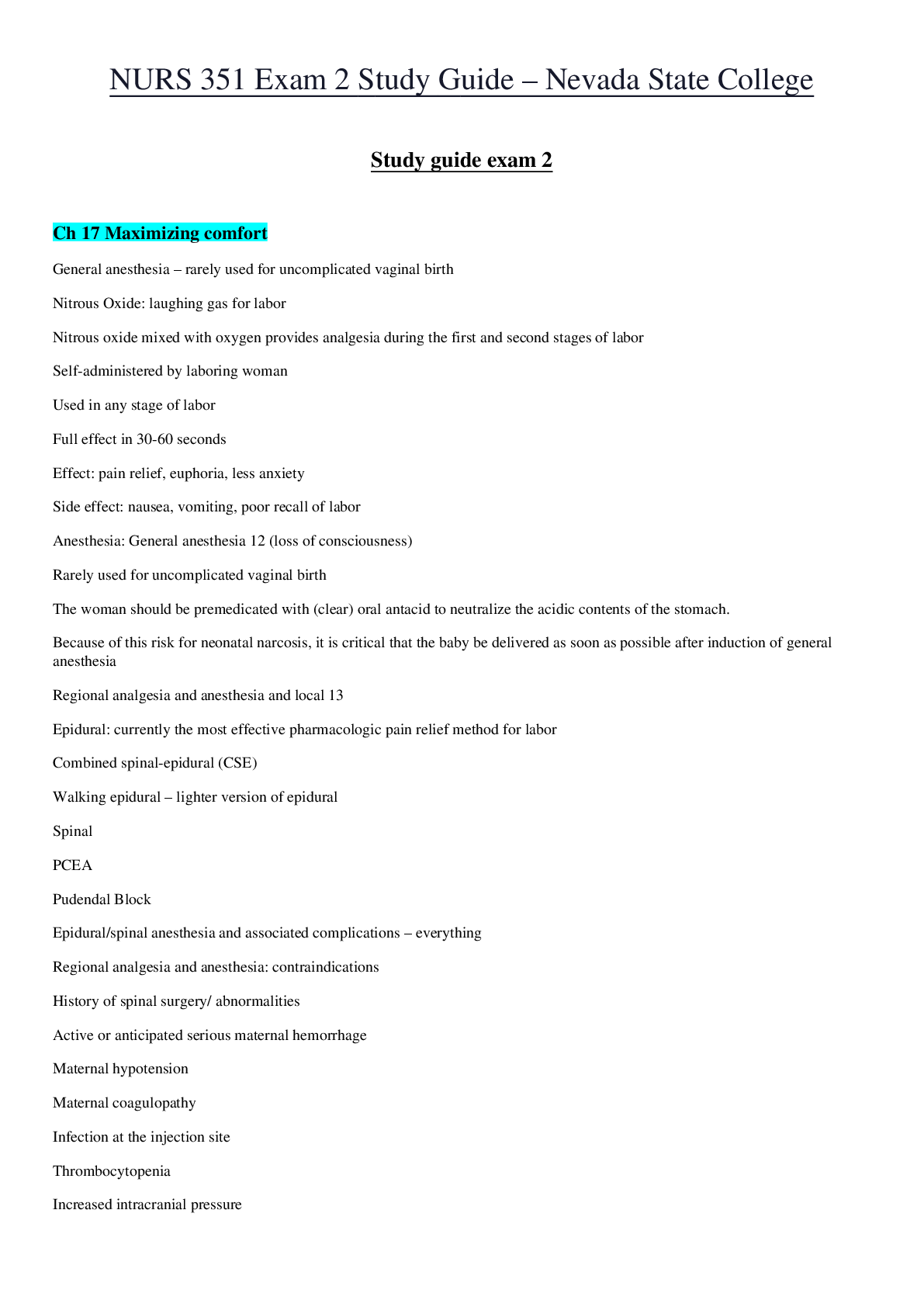
NURS 351 Exam 1 & 2 Study Guide – Nevada State College
NURS 351 Exam 1 Study Guide – Nevada State College NURS 351 Exam 2 Study Guide – Nevada State College
By Martin Freeman 3 years ago
$18.5
2
Reviews( 0 )
Document information
Connected school, study & course
About the document
Uploaded On
Dec 22, 2020
Number of pages
21
Written in
Additional information
This document has been written for:
Uploaded
Dec 22, 2020
Downloads
0
Views
30


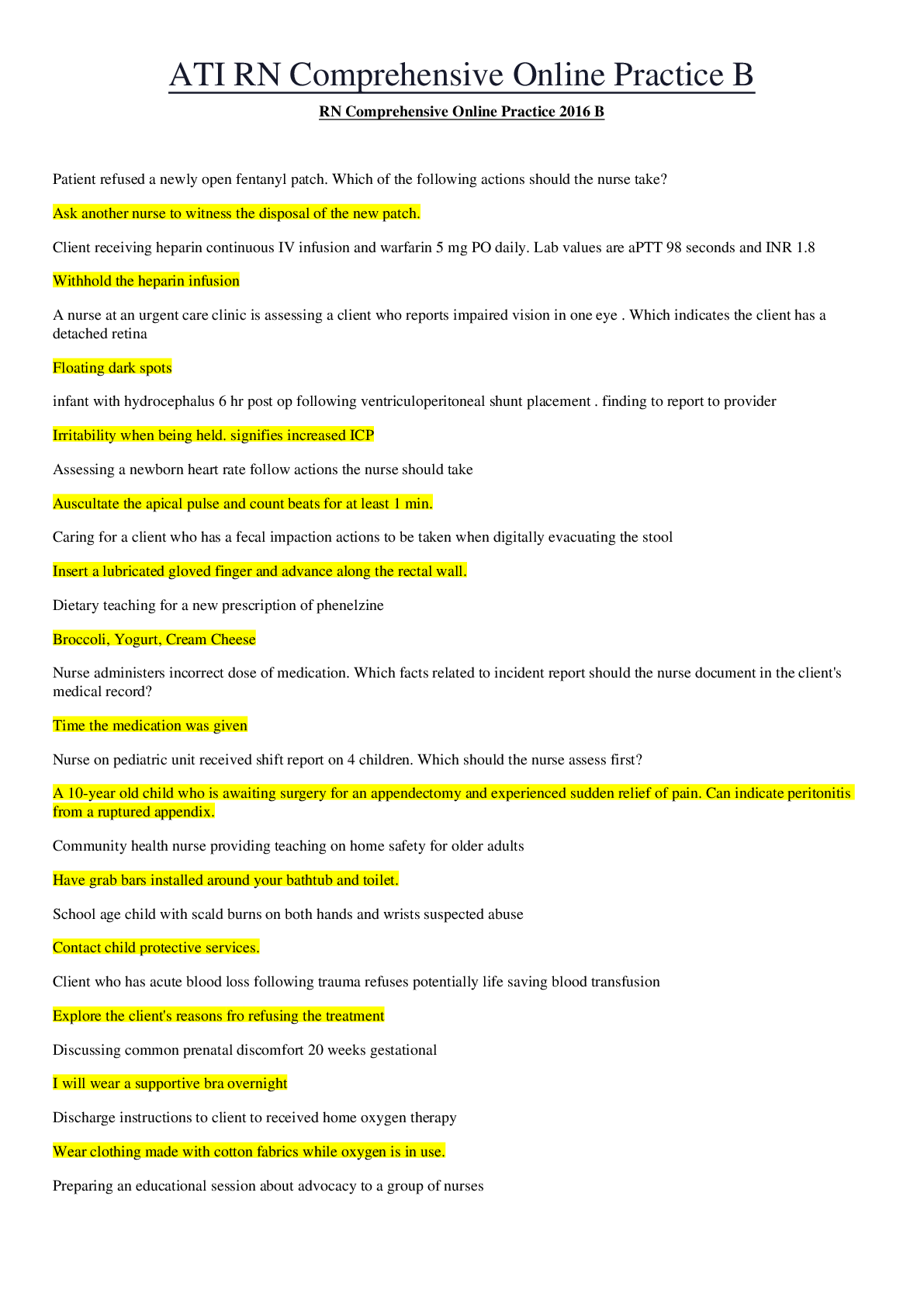
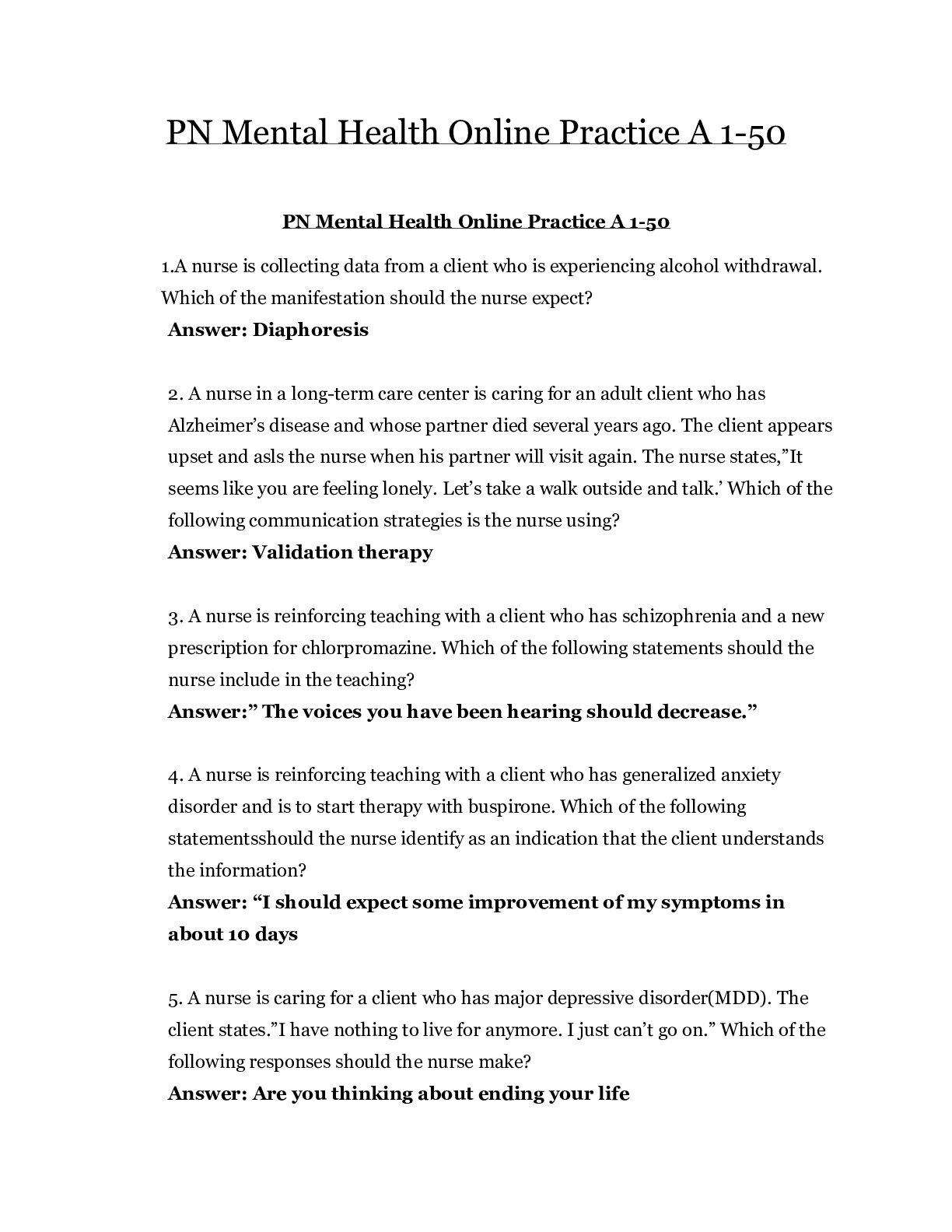
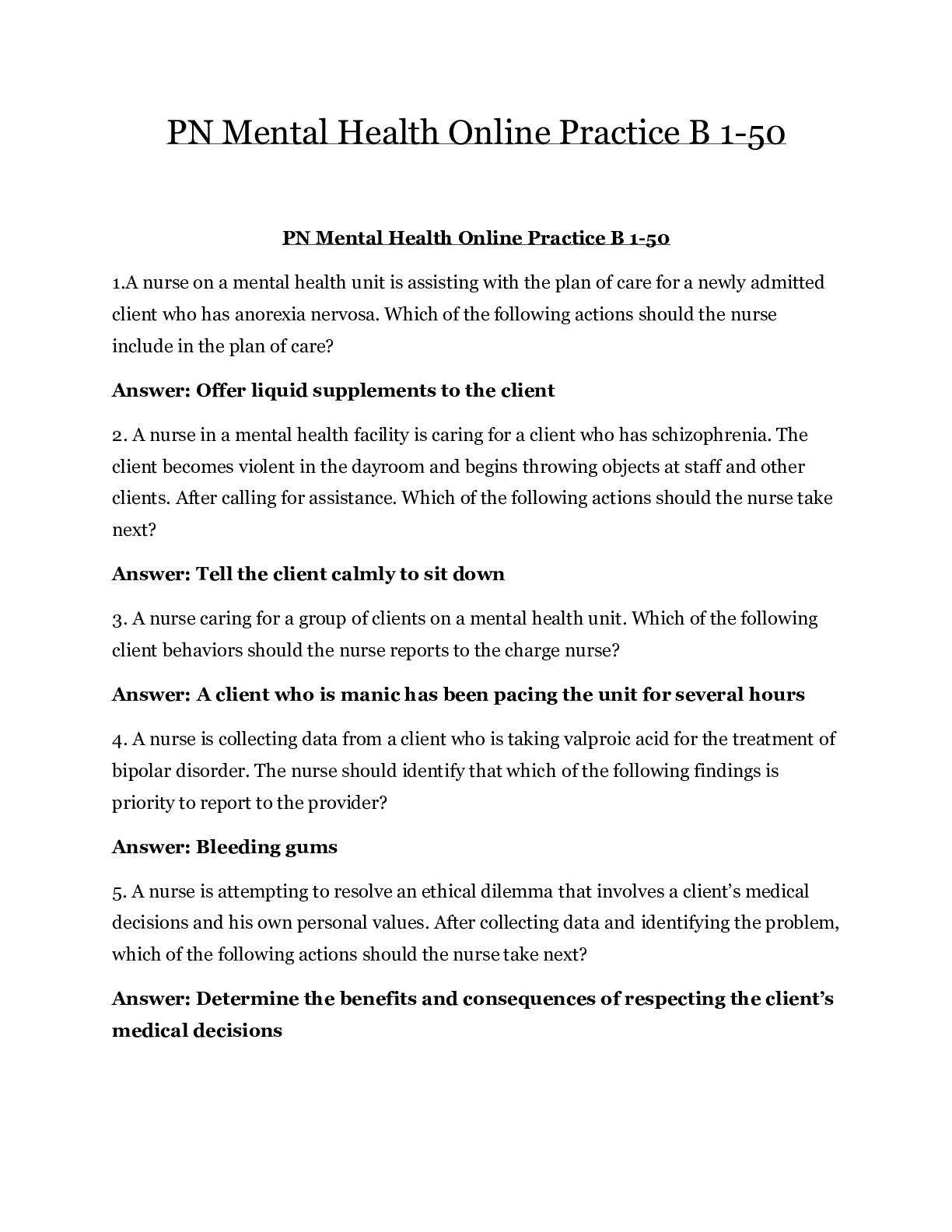
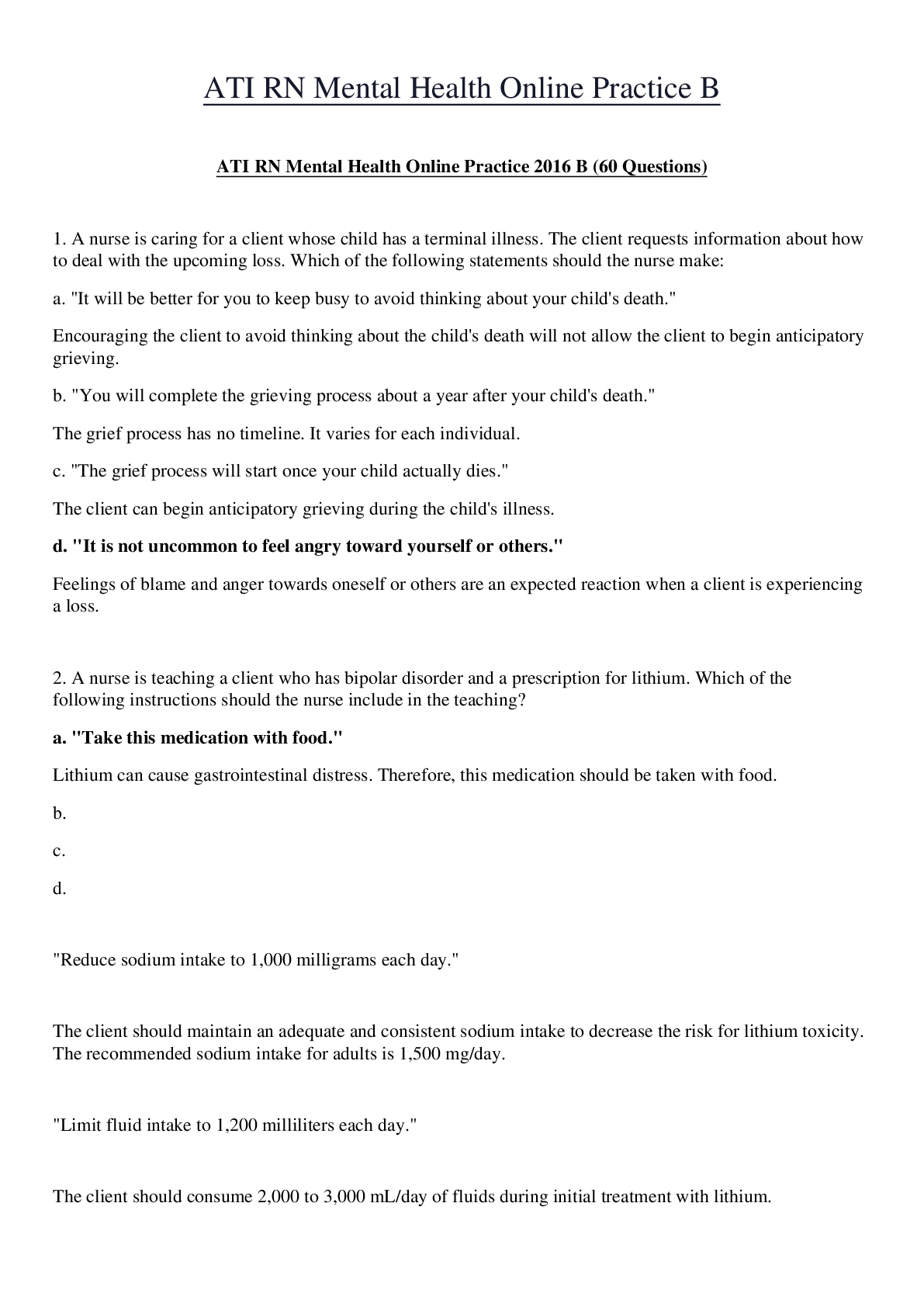


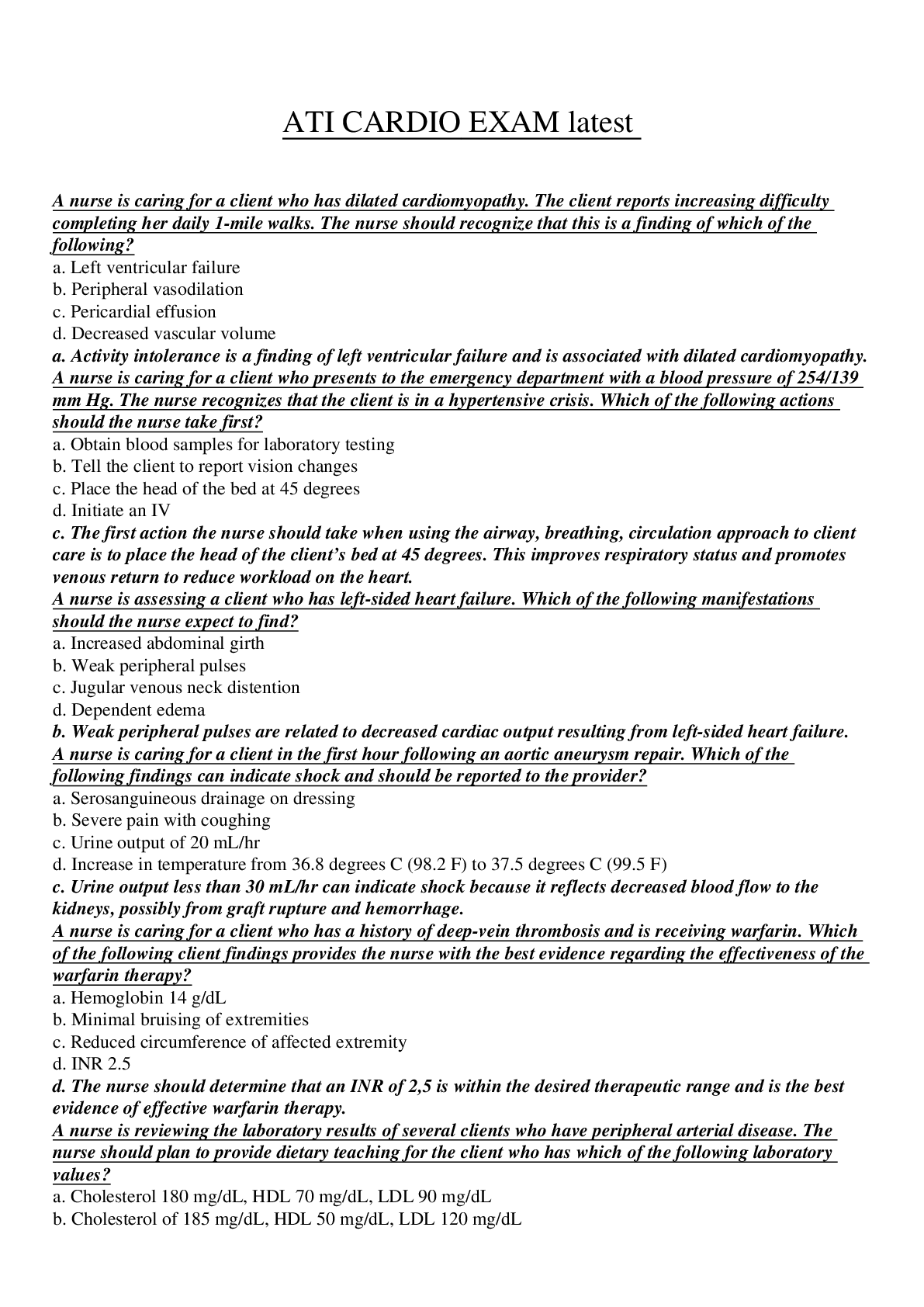
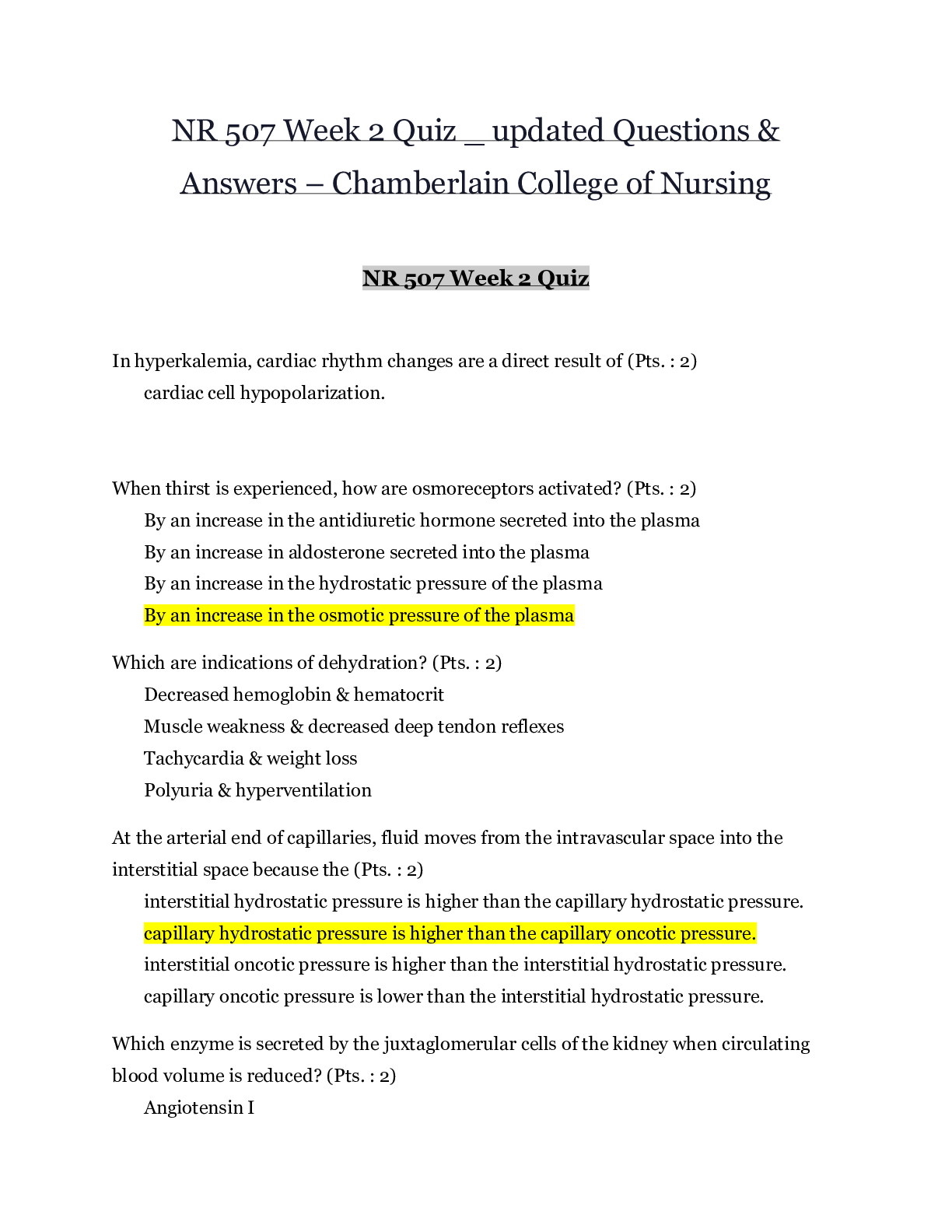
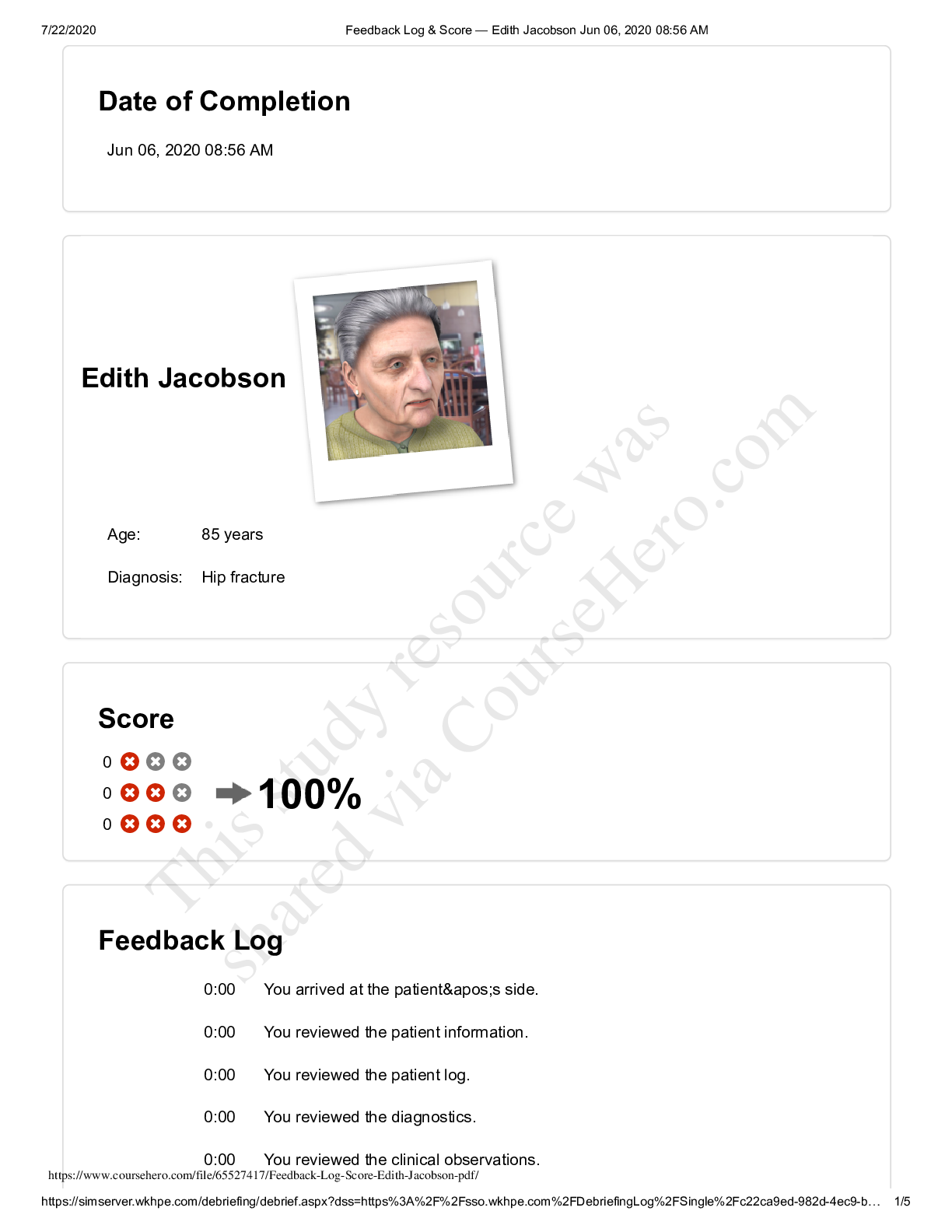
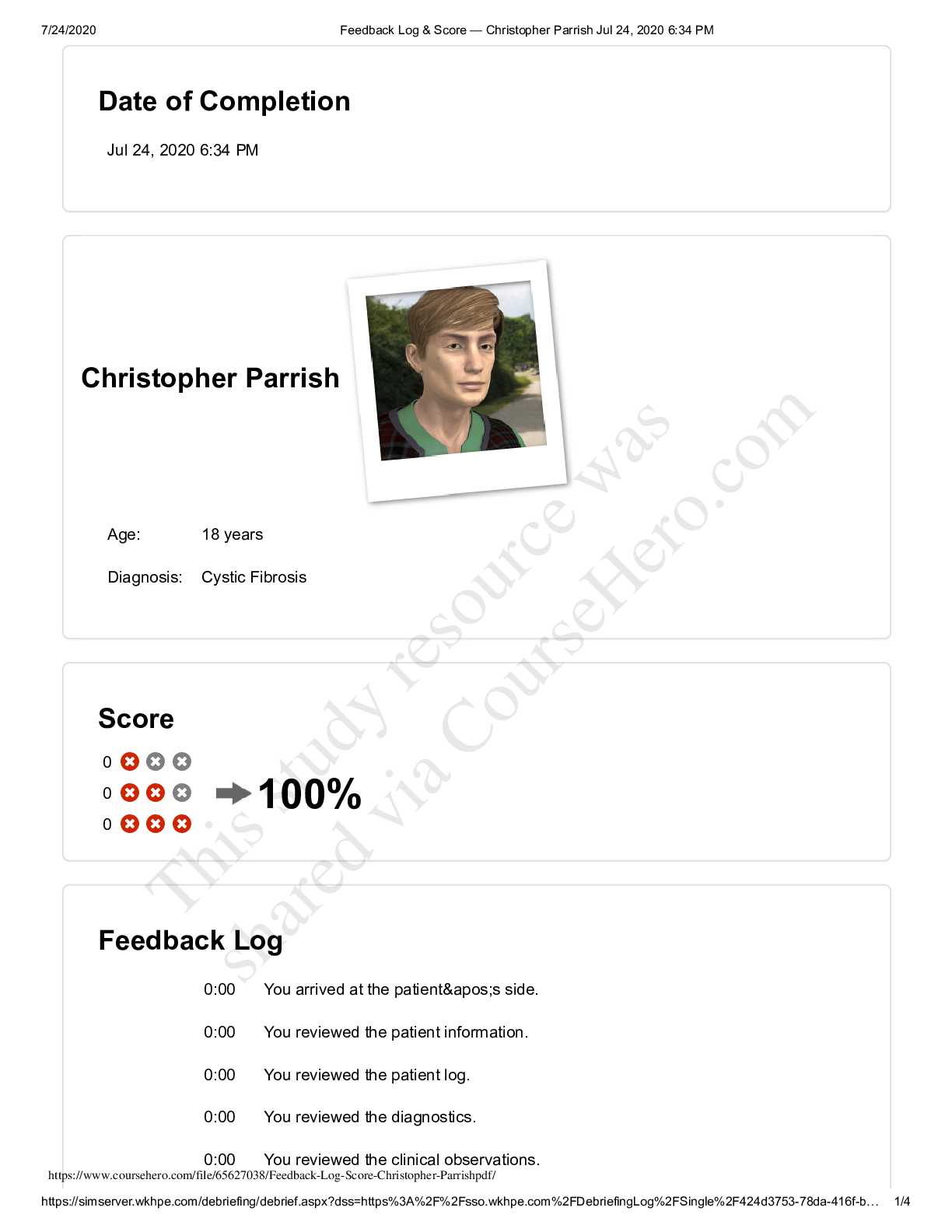
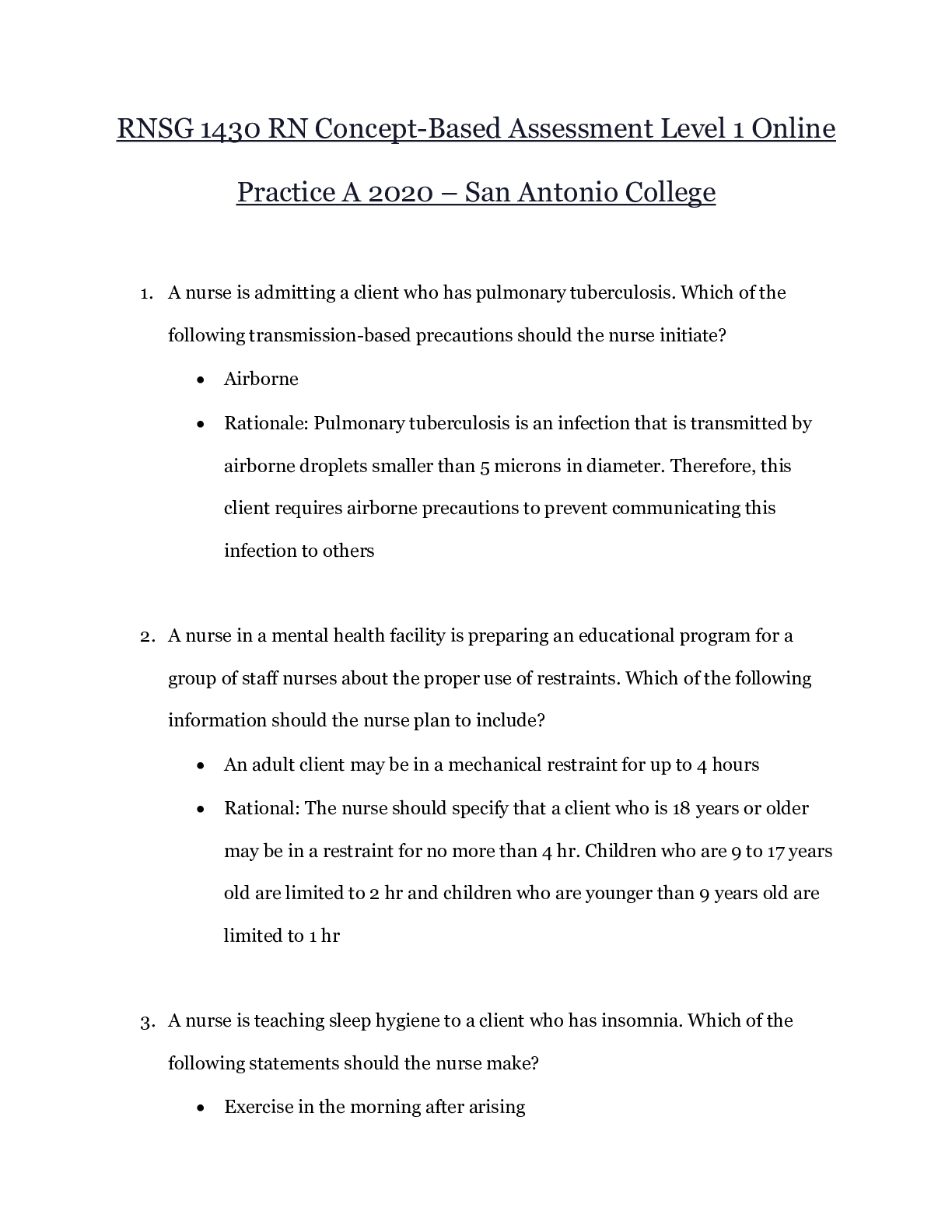


 – CHAMBERLAIN COLLEGE OF NURSING.png)
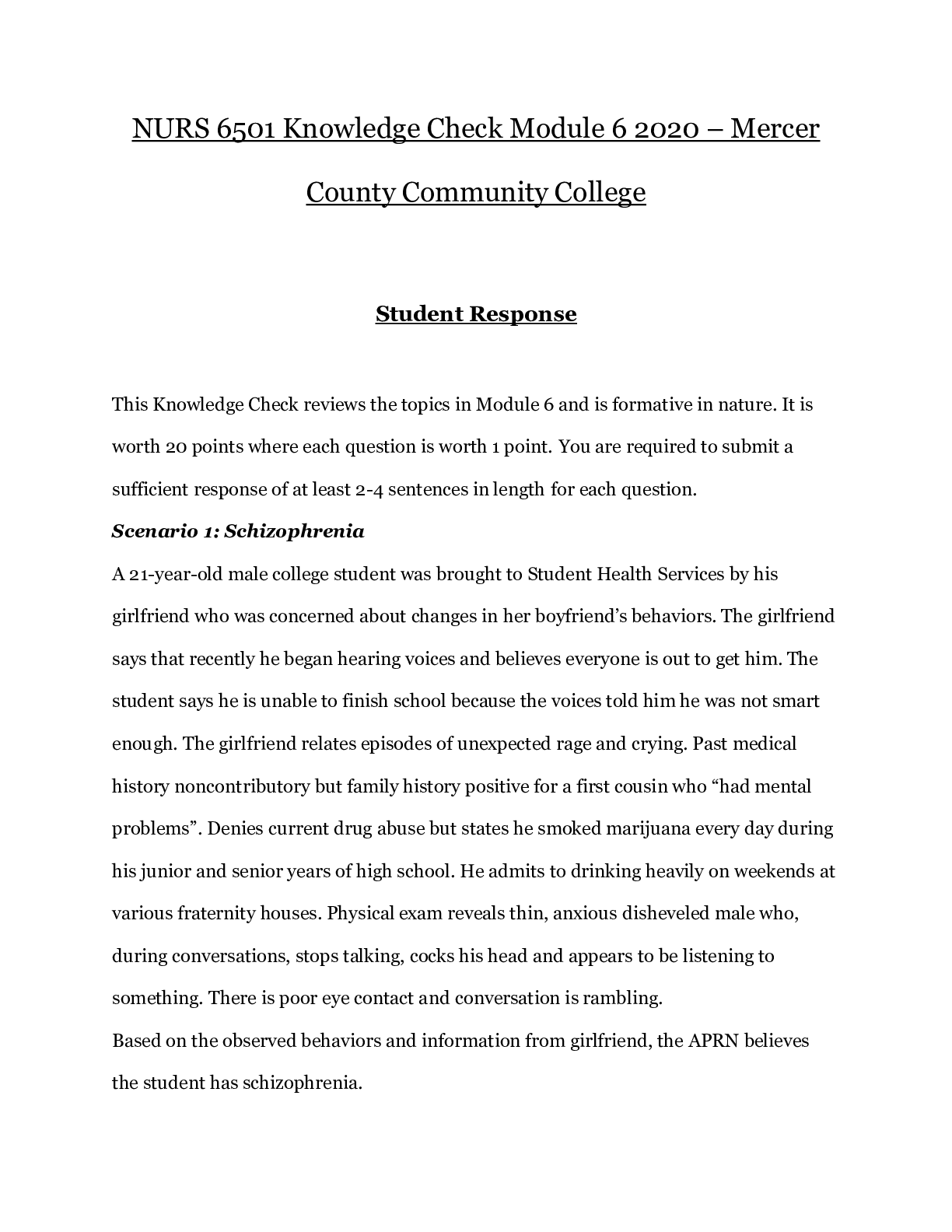
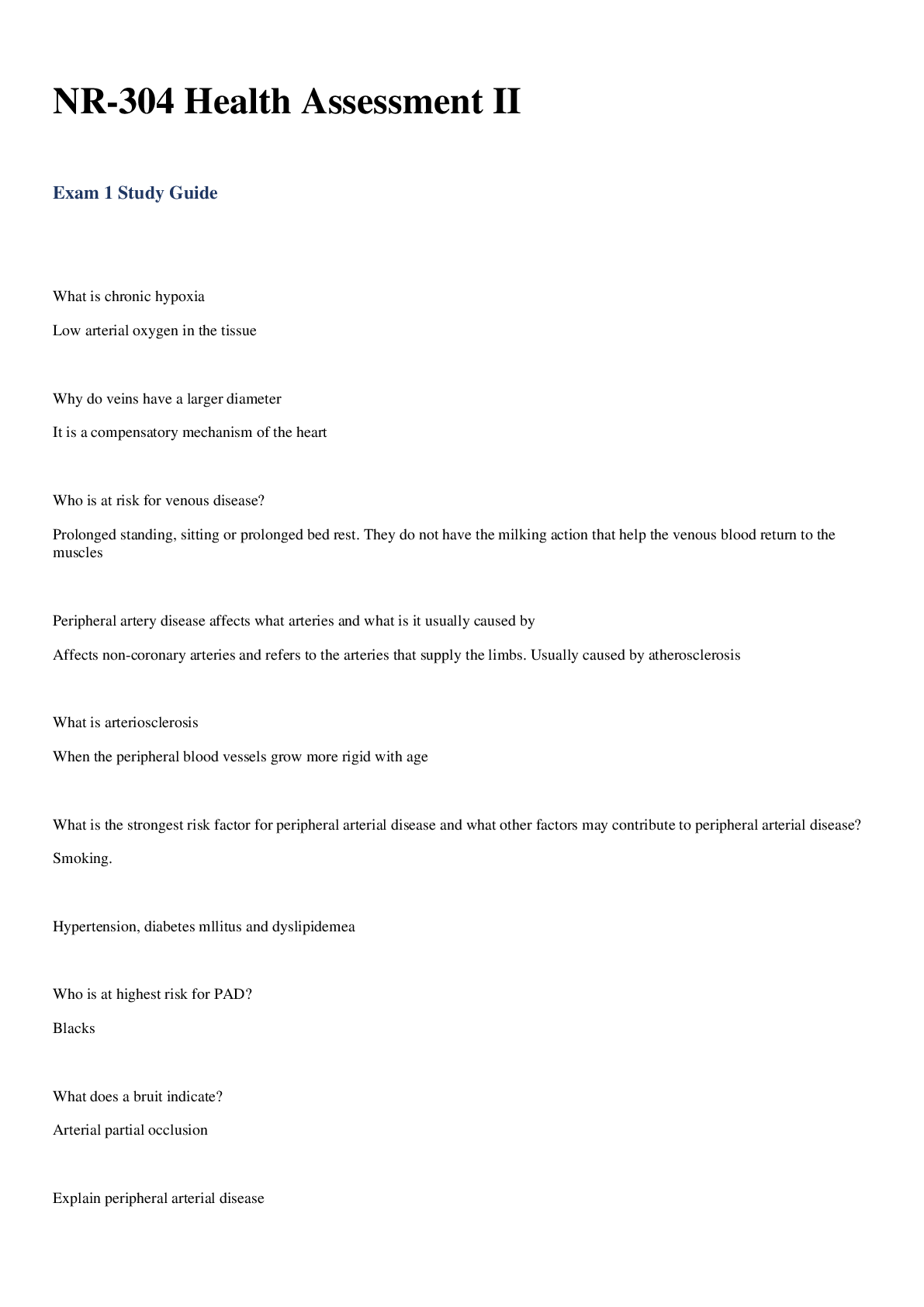

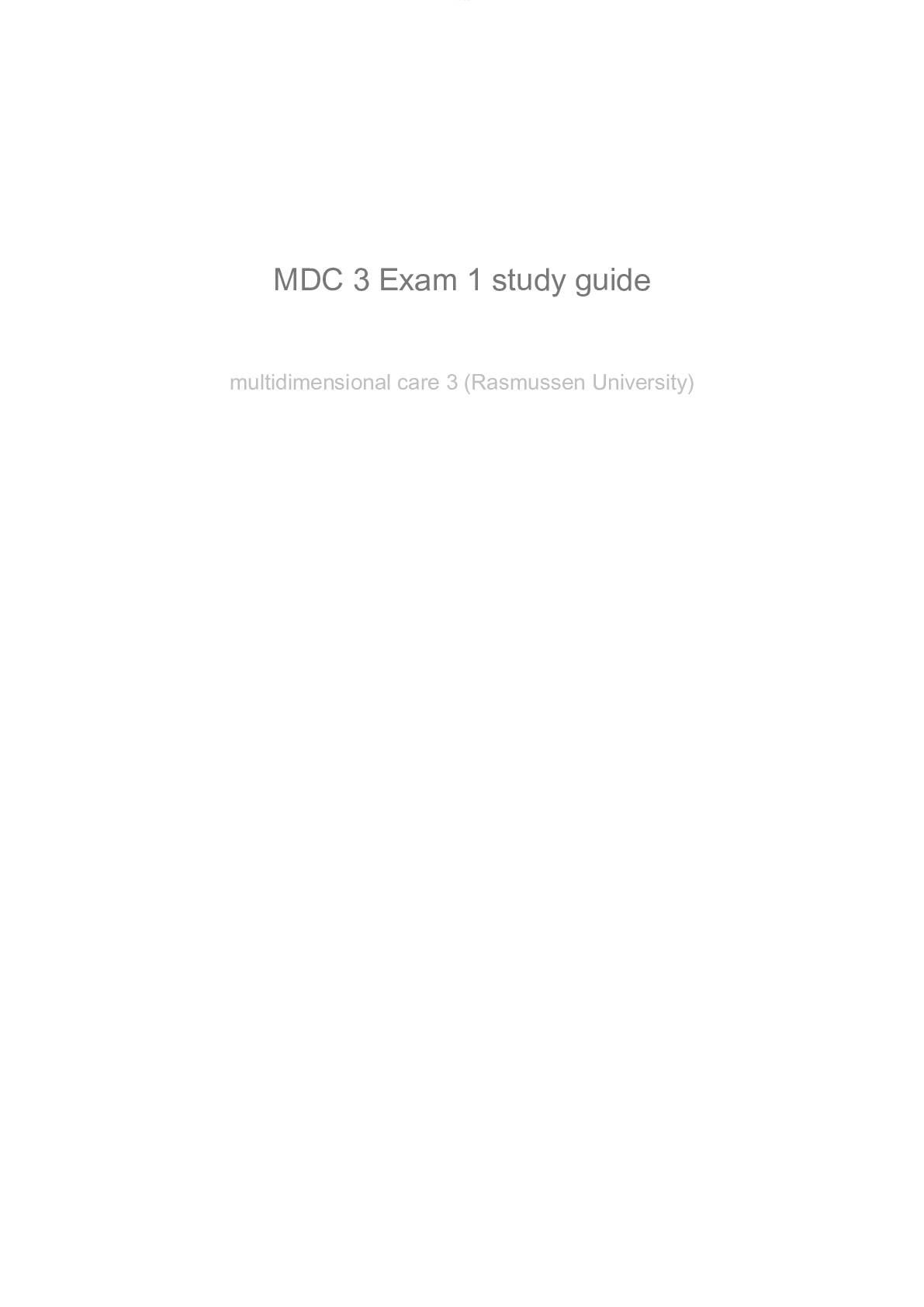

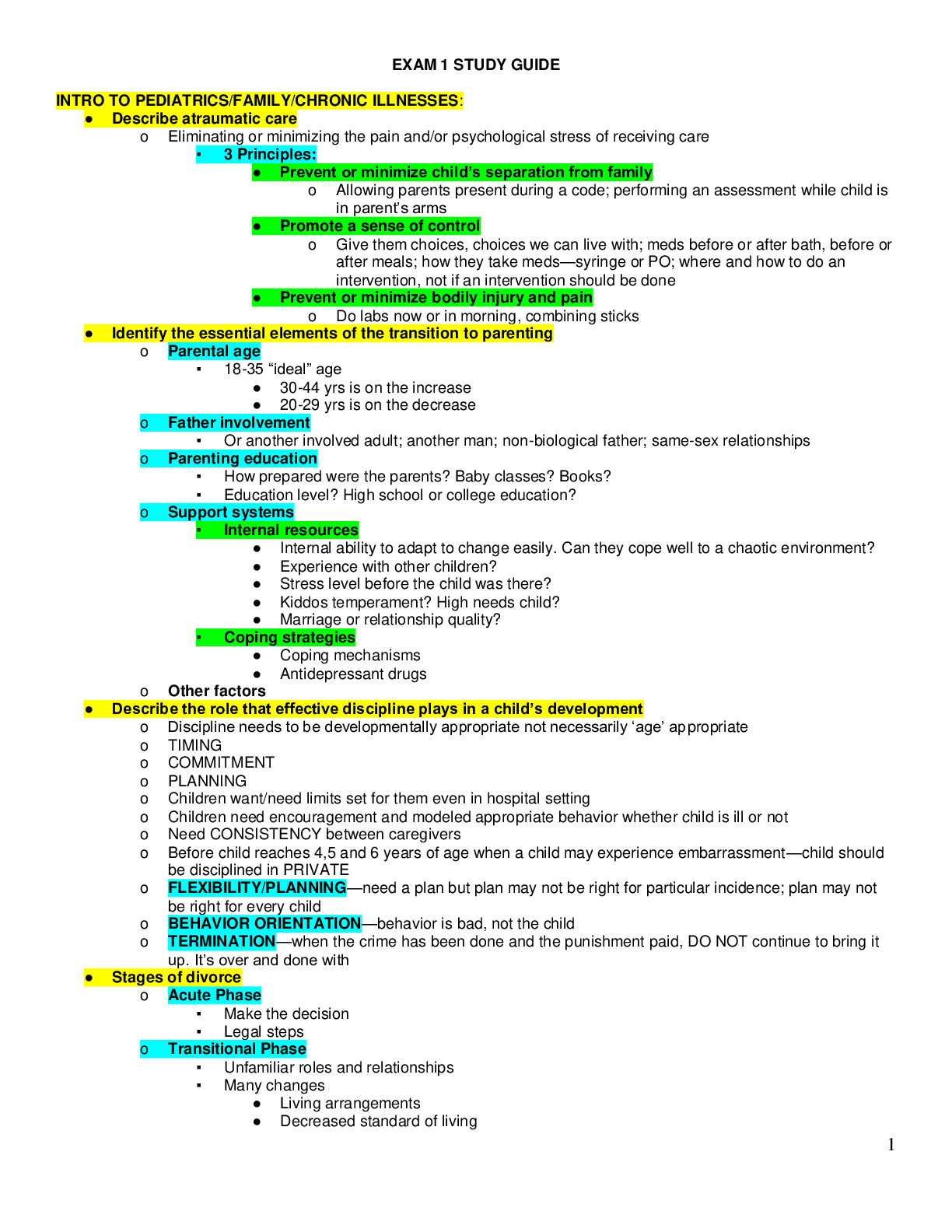

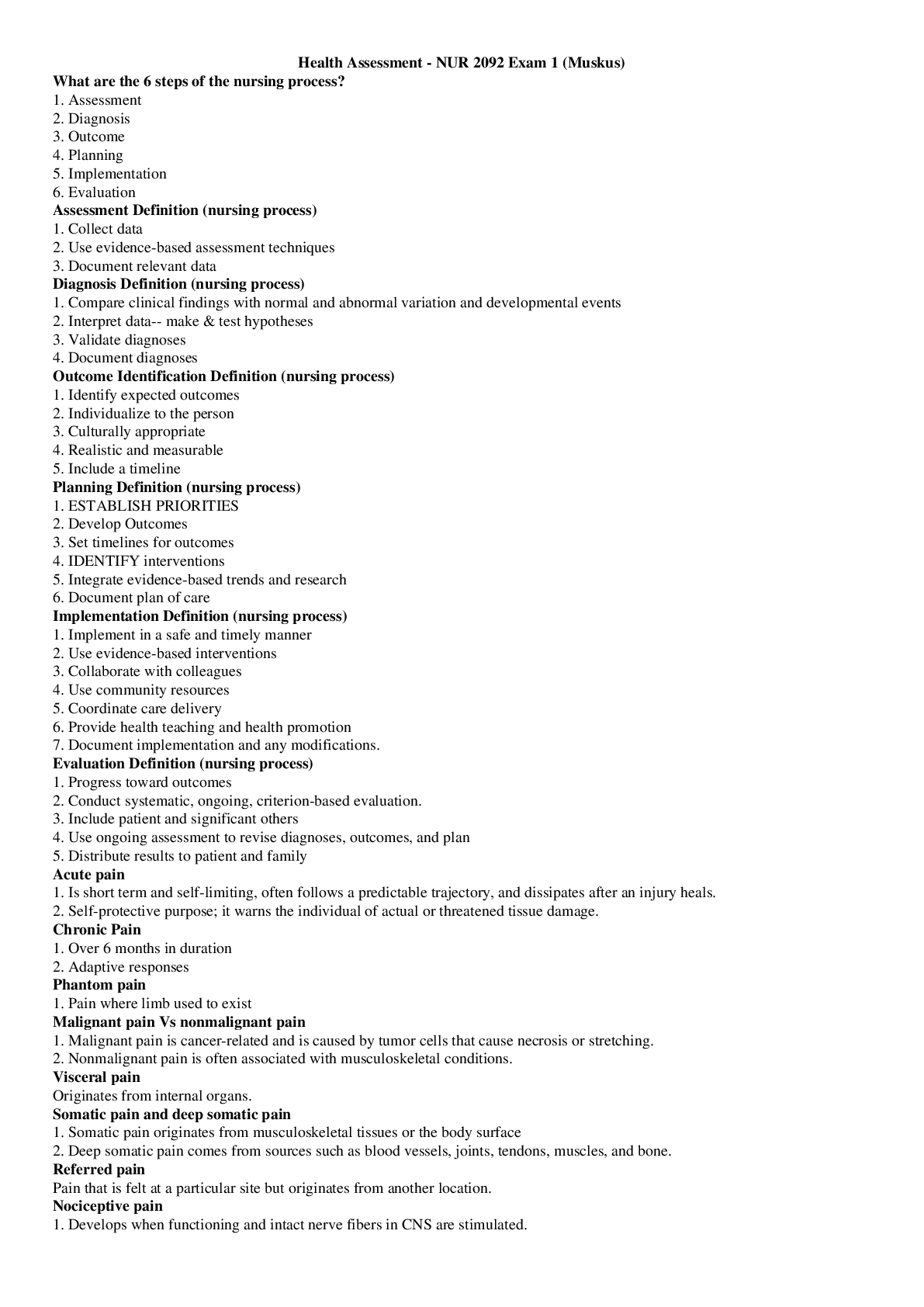
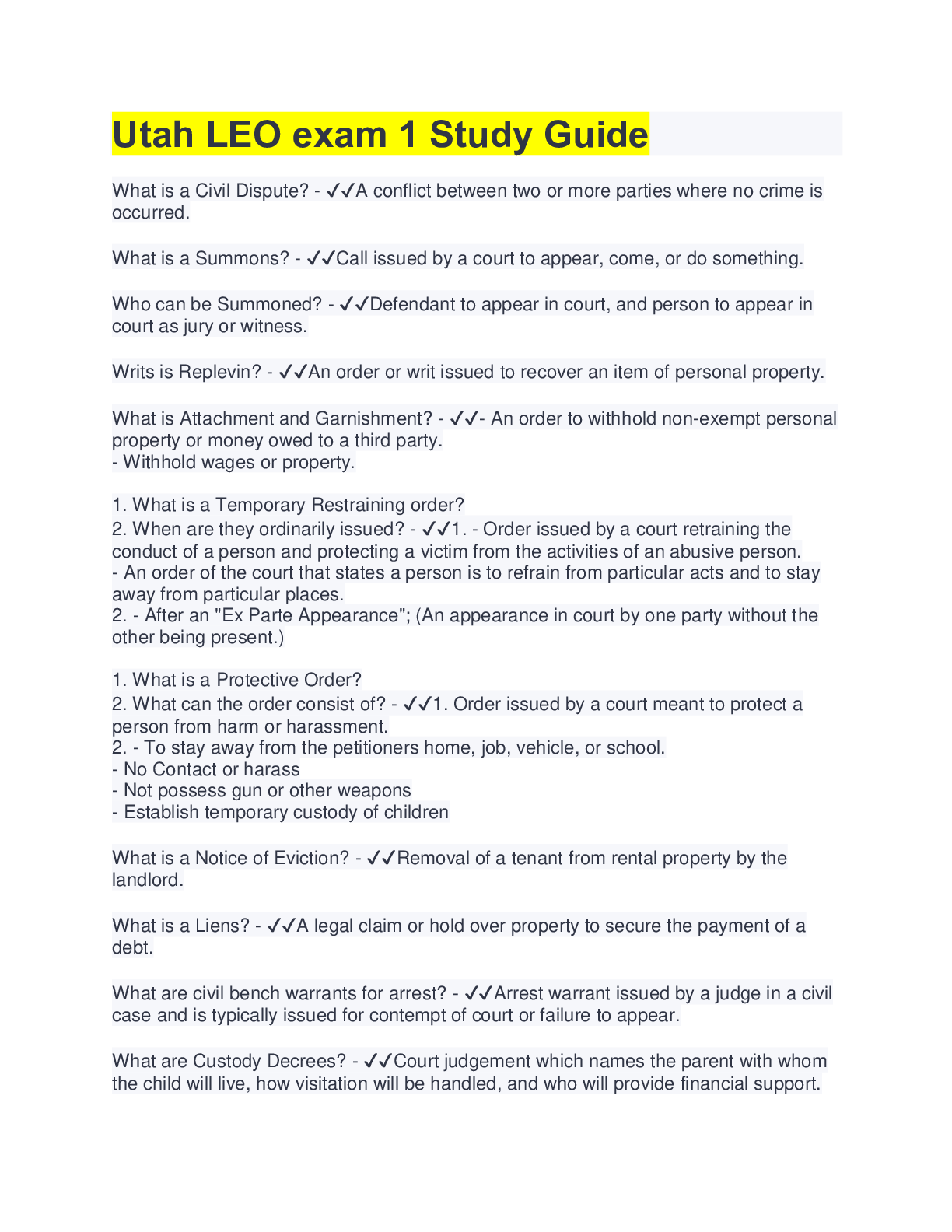
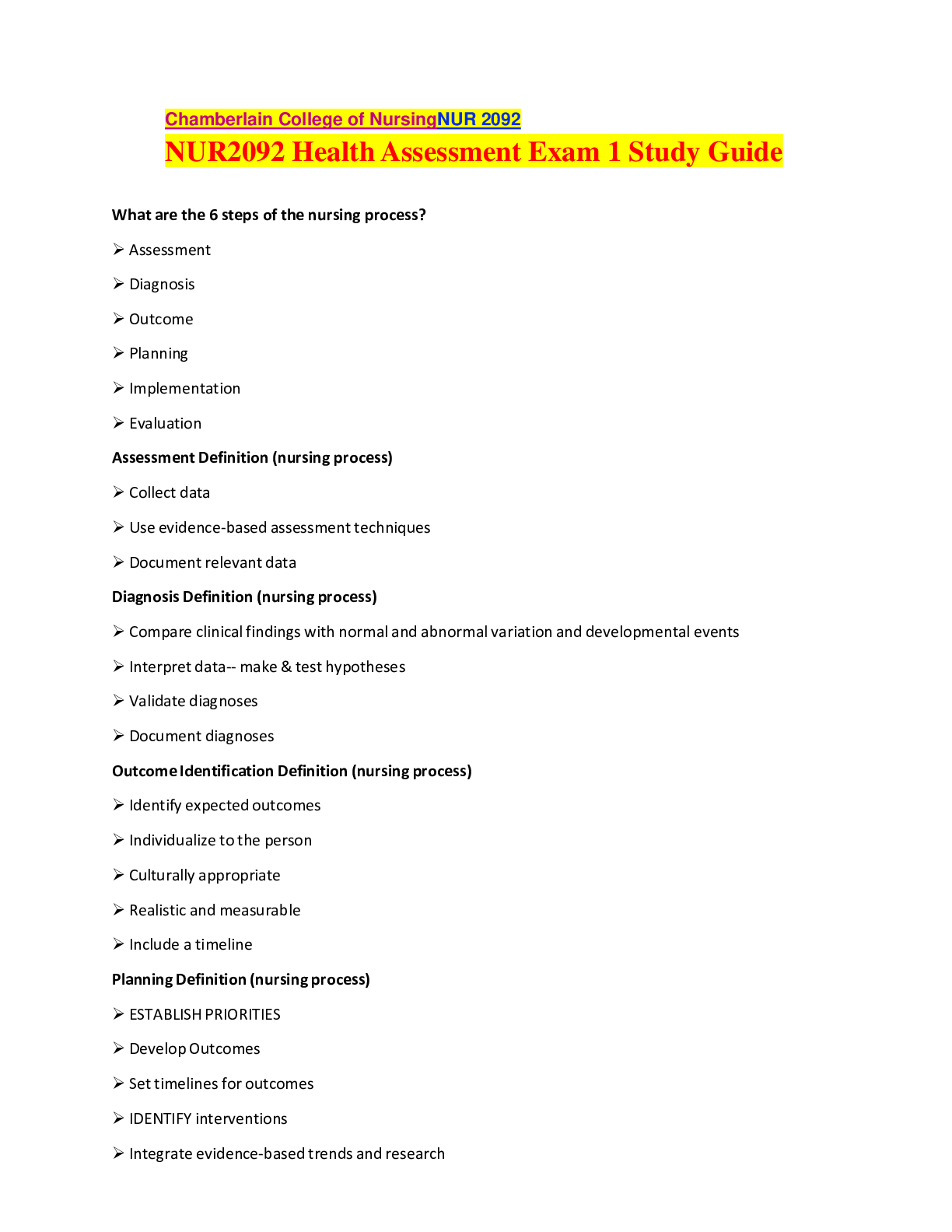

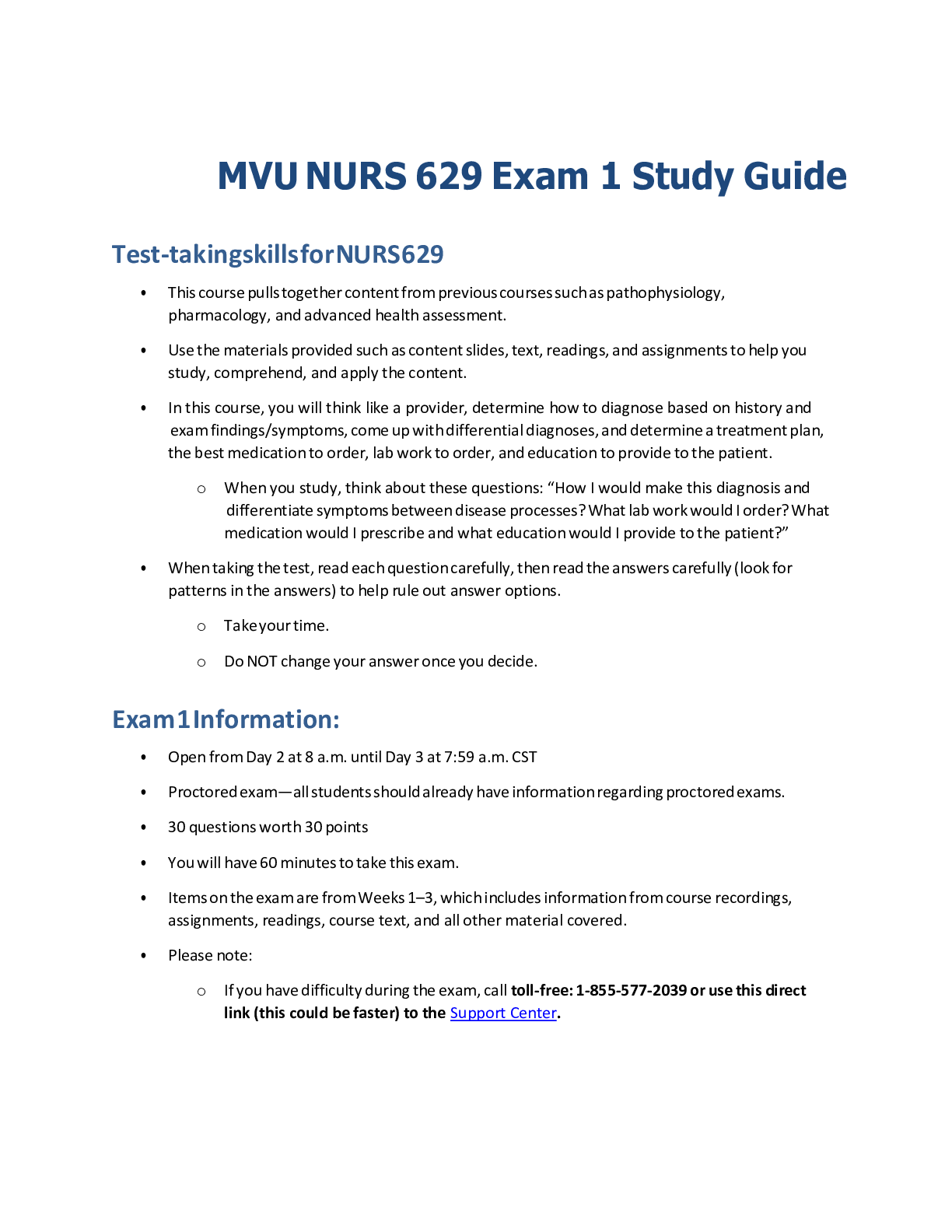
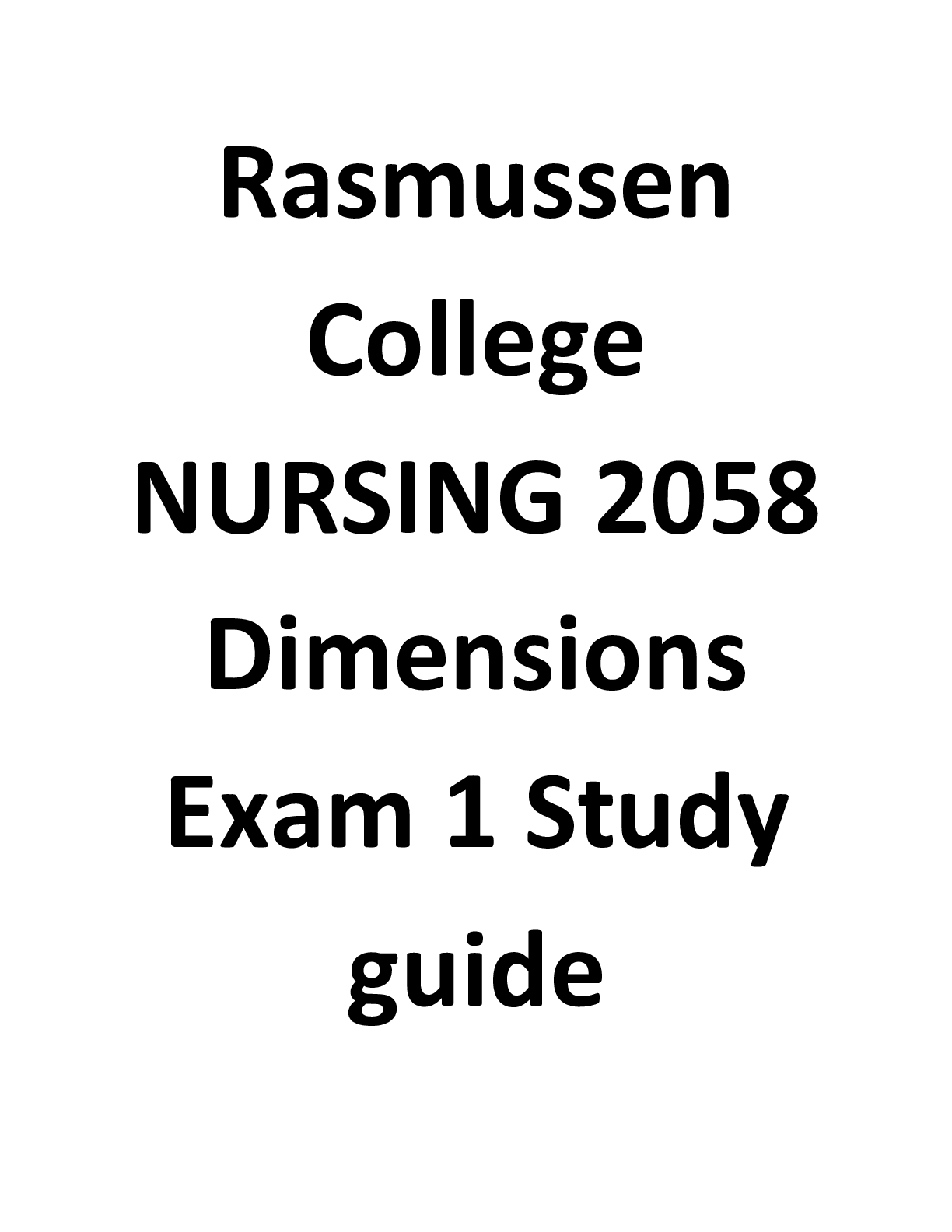
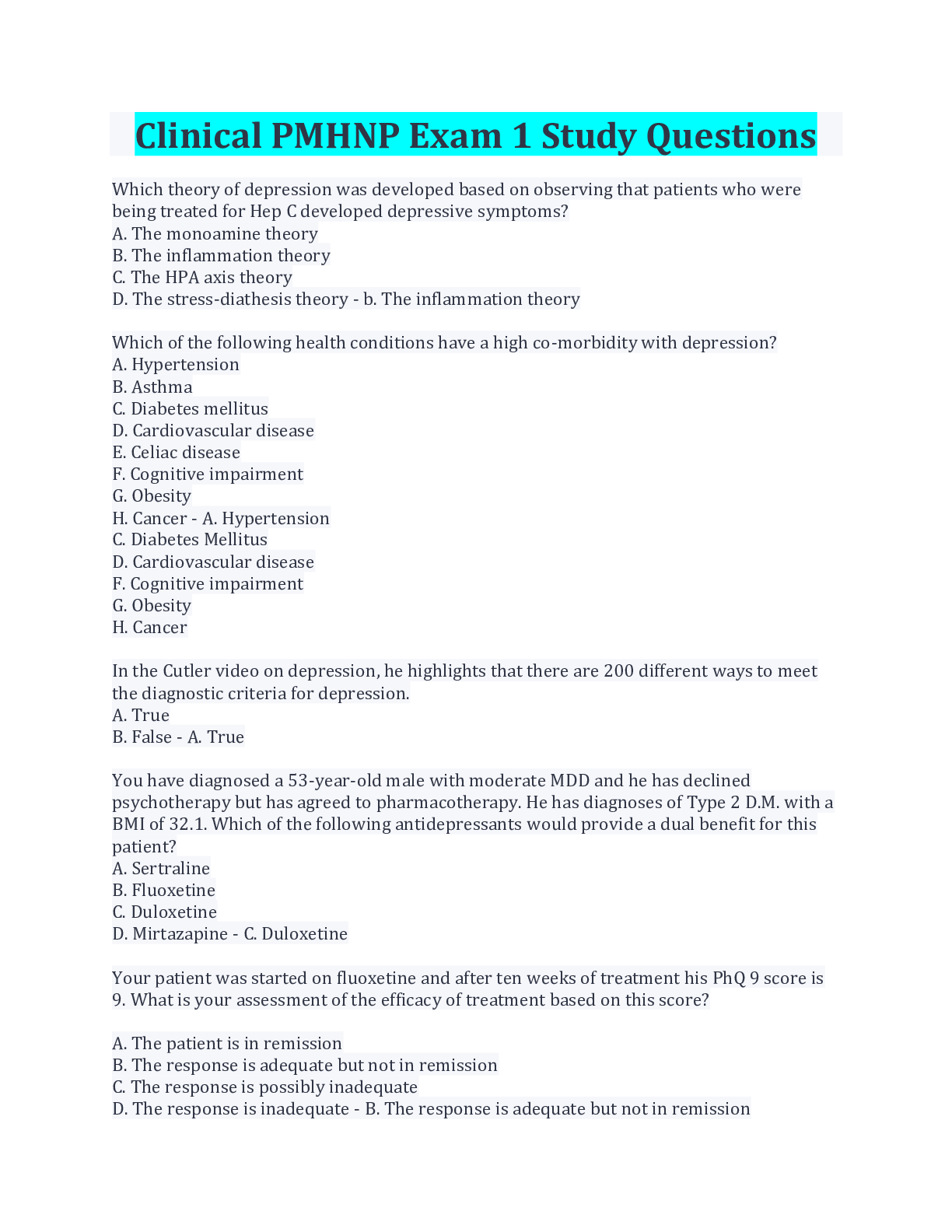
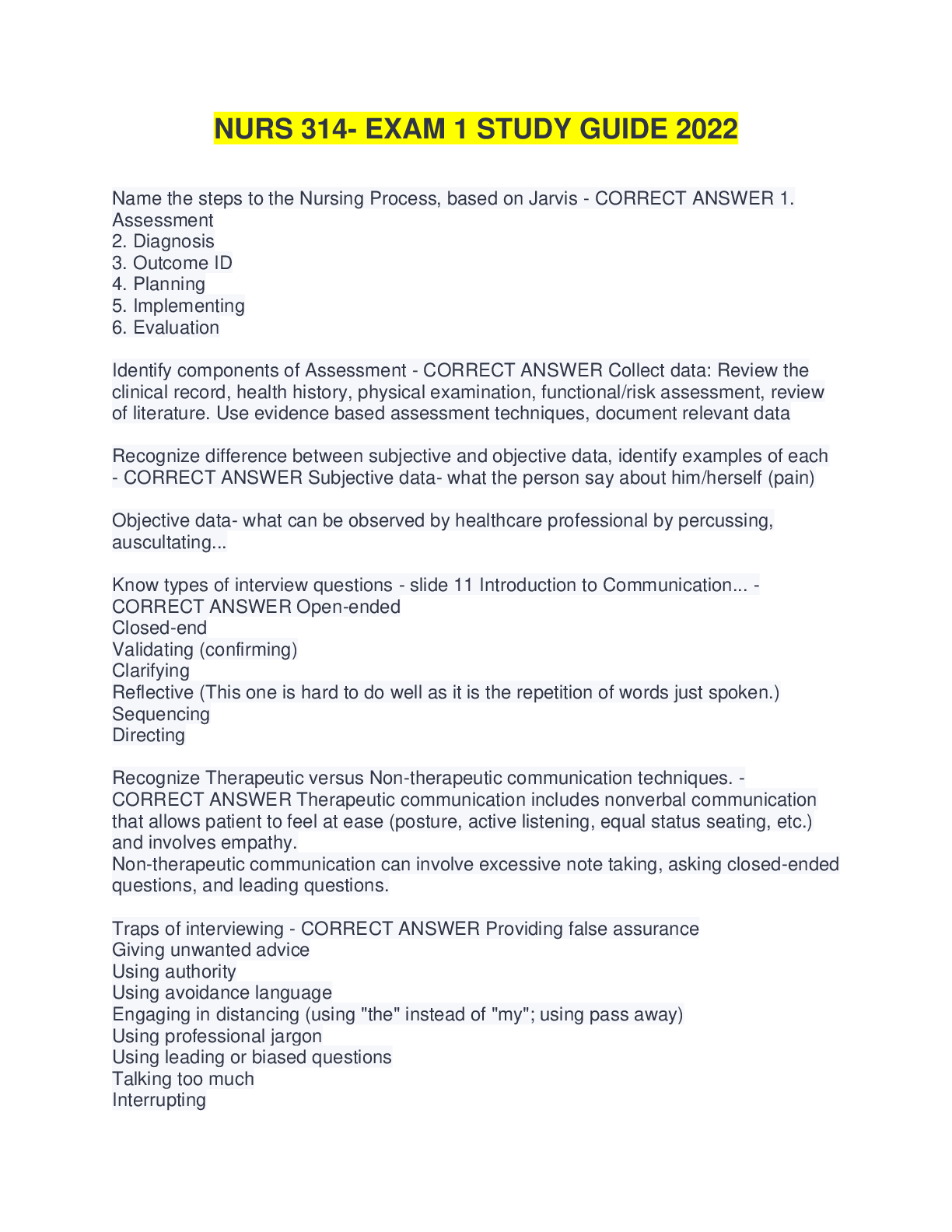
.png)
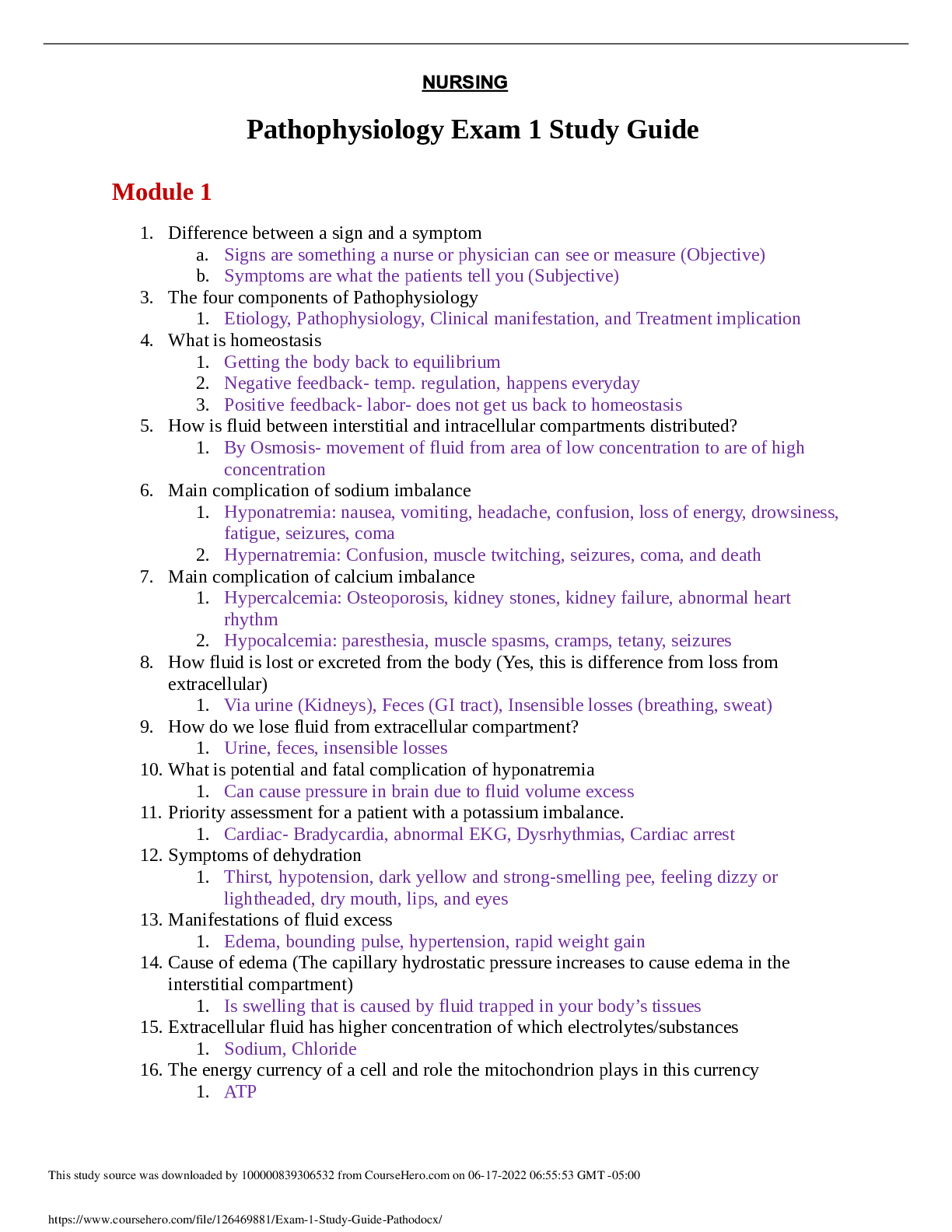
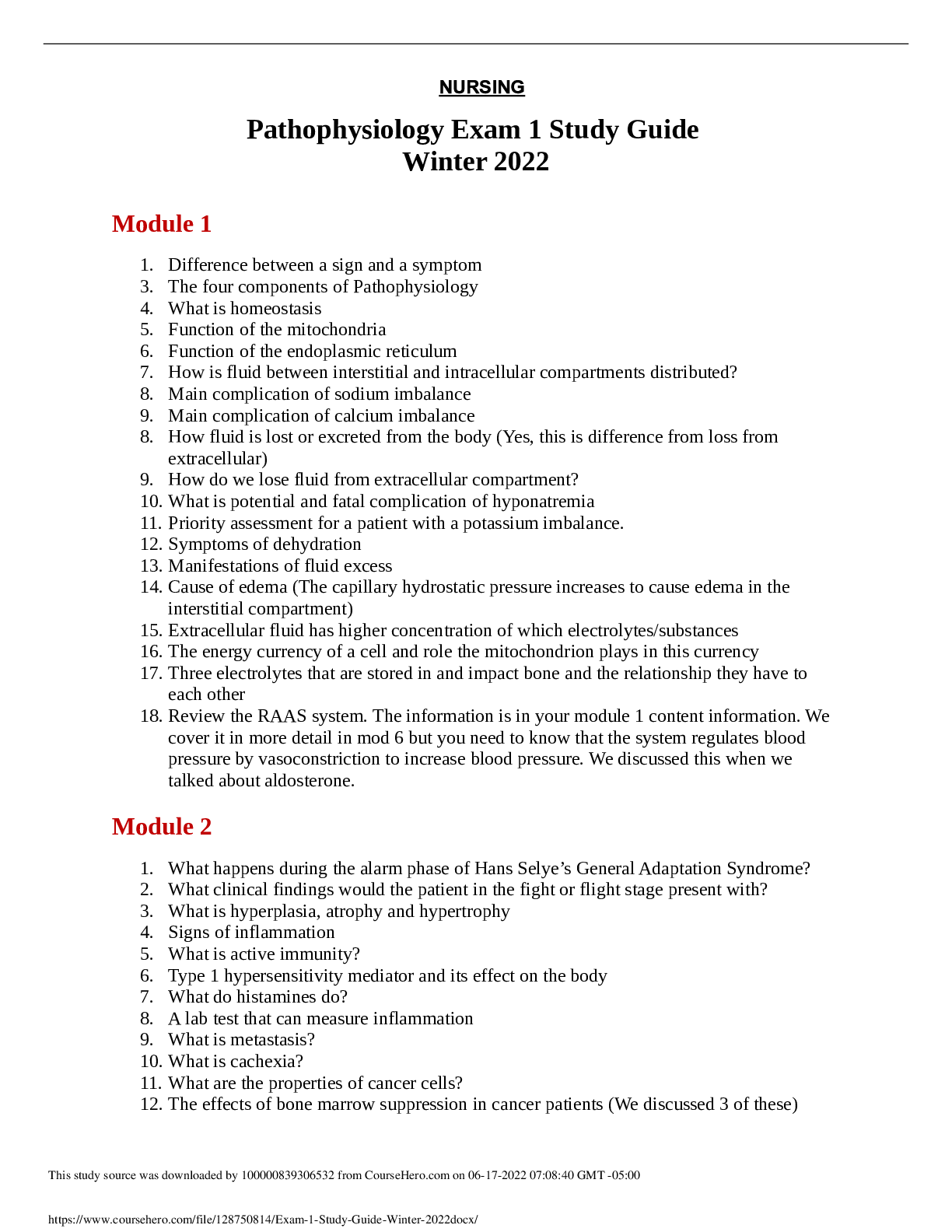
.png)

